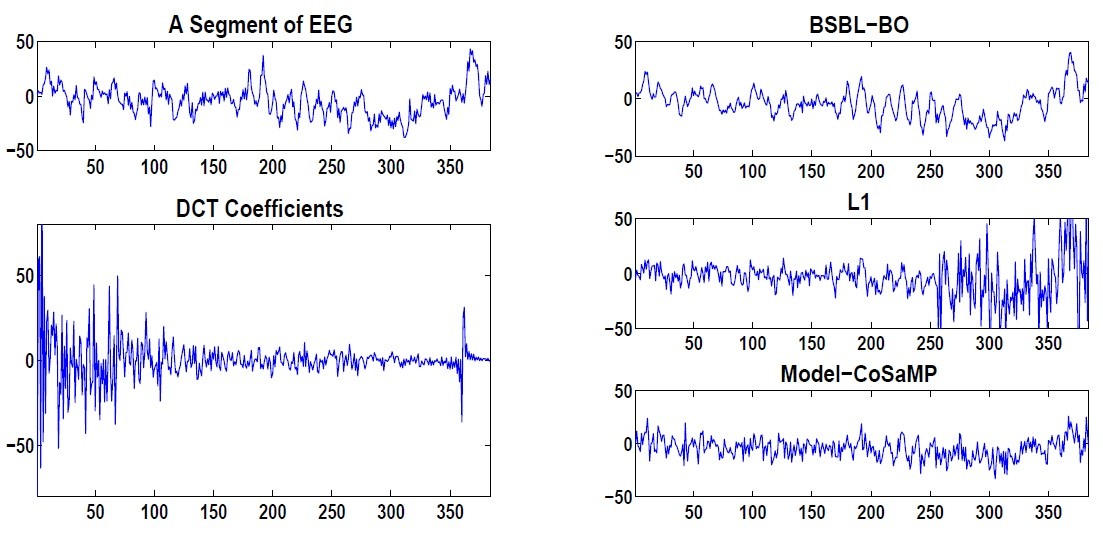博文
我们一篇脑电信号的压缩感知文章被IEEE T-BME接收了
|||
Our paper on compressed sensing of EEG for wireless telemonitoring has been accepted by IEEE Trans. on Biomedical Engineering.
Here is the summary of this paper:
(1) EEG在时域不是稀疏的,在其它变换域(比如离散余弦变换域,小波域)也不是稀疏的(如上图中左下子图所示);
(2) 对于这种非稀疏信号,我们采用BSBL框架中的算法BSBL-BO来恢复;
(3) 恢复的质量不仅用常规的性能评价指标来衡量,还采用独立分量分析(ICA)分解来衡量。当恢复的信号有较大误差时,分解出来的独立分量会出现失真。我们试验显示,BSBL恢复的信号的质量能保证独立分量不会出现明显的失真。
(4) 小波压缩与压缩传感的客观比较在压缩传感领域常常被有意或无意地忽视。文中我们用客观冷静的观点评价了两者的优劣。
这篇文章是我们第二篇关于非稀疏信号重建的文章。也是我们脑机接口项目的第一部。不过尽管刚刚被杂志接收,但是里面的算法对我们实验室来说已经过时了。我们现在有更好的算法,并将在下个月投出去。
Anyway, here is the paper:
Zhilin Zhang, Tzyy-Ping Jung, Scott Makeig, Bhaskar D. Rao, Compressed Sensing of EEG for Wireless Telemonitoring with Low Energy Consumption and Inexpensive Hardware, to appear in IEEE Trans. on Biomedical Engineering
Abstract:
Telemonitoring of electroencephalogram (EEG) through wireless body-area networks is an evolving direction in personalized medicine. Among various constraints in designing such a system, three important constraints are energy consumption, data compression, and device cost. Conventional data compression methodologies, although effective in data compression, consumes significant energy and cannot reduce device cost. Compressed sensing (CS), as an emerging data compression methodology, is promising in catering to these constraints. However, EEG is non-sparse in the time domain and also non-sparse in transformed domains (such as the wavelet domain). Therefore, it is extremely difficult for current CS algorithms to recover EEG with the quality that satisfies the requirements of clinical diagnosis and engineering applications. Recently, Block Sparse Bayesian Learning (BSBL) was proposed as a new method to the CS problem. This study introduces the technique to the telemonitoring of EEG. Experimental results show that its recovery quality is better than state-of-the-art CS algorithms, and sufficient for practical use. These results suggest that BSBL is very promising for telemonitoring of EEG and other non-sparse physiological signals.
The code and related data can be downloaded at: https://sites.google.com/site/researchbyzhang/bsbl, or http://dsp.ucsd.edu/~zhilin/BSBL.html
https://wap.sciencenet.cn/blog-765184-616319.html
上一篇:Approximate Message Passing vs. Sparse Bayesian Learning?
下一篇:人生如茶,空杯以对
Here is the summary of this paper:
(1) EEG在时域不是稀疏的,在其它变换域(比如离散余弦变换域,小波域)也不是稀疏的(如上图中左下子图所示);
(2) 对于这种非稀疏信号,我们采用BSBL框架中的算法BSBL-BO来恢复;
(3) 恢复的质量不仅用常规的性能评价指标来衡量,还采用独立分量分析(ICA)分解来衡量。当恢复的信号有较大误差时,分解出来的独立分量会出现失真。我们试验显示,BSBL恢复的信号的质量能保证独立分量不会出现明显的失真。
(4) 小波压缩与压缩传感的客观比较在压缩传感领域常常被有意或无意地忽视。文中我们用客观冷静的观点评价了两者的优劣。
这篇文章是我们第二篇关于非稀疏信号重建的文章。也是我们脑机接口项目的第一部。不过尽管刚刚被杂志接收,但是里面的算法对我们实验室来说已经过时了。我们现在有更好的算法,并将在下个月投出去。
Anyway, here is the paper:
Zhilin Zhang, Tzyy-Ping Jung, Scott Makeig, Bhaskar D. Rao, Compressed Sensing of EEG for Wireless Telemonitoring with Low Energy Consumption and Inexpensive Hardware, to appear in IEEE Trans. on Biomedical Engineering
Abstract:
Telemonitoring of electroencephalogram (EEG) through wireless body-area networks is an evolving direction in personalized medicine. Among various constraints in designing such a system, three important constraints are energy consumption, data compression, and device cost. Conventional data compression methodologies, although effective in data compression, consumes significant energy and cannot reduce device cost. Compressed sensing (CS), as an emerging data compression methodology, is promising in catering to these constraints. However, EEG is non-sparse in the time domain and also non-sparse in transformed domains (such as the wavelet domain). Therefore, it is extremely difficult for current CS algorithms to recover EEG with the quality that satisfies the requirements of clinical diagnosis and engineering applications. Recently, Block Sparse Bayesian Learning (BSBL) was proposed as a new method to the CS problem. This study introduces the technique to the telemonitoring of EEG. Experimental results show that its recovery quality is better than state-of-the-art CS algorithms, and sufficient for practical use. These results suggest that BSBL is very promising for telemonitoring of EEG and other non-sparse physiological signals.
The code and related data can be downloaded at: https://sites.google.com/site/researchbyzhang/bsbl, or http://dsp.ucsd.edu/~zhilin/BSBL.html
https://wap.sciencenet.cn/blog-765184-616319.html
上一篇:Approximate Message Passing vs. Sparse Bayesian Learning?
下一篇:人生如茶,空杯以对
扫一扫,分享此博文
全部作者的精选博文
全部作者的其他最新博文
全部精选博文导读
相关博文
- • Minerals线下恳谈会:履践致远、与时偕行——对话中国科学院广州地球化学研究所期刊合作学者
- • 聚英才 建高地 | 北京理工大学“特立青年学者”全球招聘开启
- • 700年后日本或濒临灭绝?日本学者推算预测:届时或仅剩1名15岁以下孩子
- • [转载]【同位素视角】非英语母语学者如何区分’e.g.’, ‘i.e.’, ‘namely’与‘such as’等混淆难题
- • 美国佐治亚大学等机构学者:刈割策略对Bulldog 805紫花苜蓿+Tifton 85狗牙根混播草地产量及品质的影响
- • 美国堪萨斯州立大学、密苏里大学等机构学者研究成果:土壤水分管理策略和品种多样性对紫花苜蓿产量、营养品质和农场盈利能力的影
